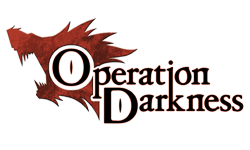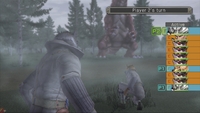|
|

|
PLATFORM
|
Xbox 360
|
BATTLE SYSTEM
|

|
INTERACTION
|

|
ORIGINALITY
|

|
STORY
|

|
MUSIC & SOUND
|

|
VISUALS
|

|
CHALLENGE
|
Unbalanced
|
COMPLETION TIME
|
More than 80 Hours
|
|
OVERALL

|
+ Unique and engaging gun-based combat...
- Destroyed by unbalanced elements.
- Camera is awful.
- Graphics are bland and low-quality.
- Permanent death without decent recruits.
+ Werewolves, vampires, and zombies!
|
Click here for scoring definitions
|
|
|
Here at RPGamer we have one cardinal rule: that every game we review must be played to completion, and after writing thirty reviews for this website, this is the first and hopefully last time I will ever break it. We also have a second cardinal rule that forbids writing in the first person, but work with me here, I'm on a roll. Operation Darkness, has beaten me, but not in the way one beats a game; rather, it has beaten me in the way one would beat a rug. Developer Success has created a unique tactical RPG that, despite many flaws, is a lot of fun, but somehow, over the course of seventy miserable hours, they took that fun and destroyed it, replacing it instead with a nightmarish concoction of frustration and sadism that has left me a broken shell.
To put it bluntly, Operation Darkness has a lot of flaws. It's graphics are shabby for an Xbox 360 game and it has a number of interface issues, including a poorly implemented shopping system and a camera so twitchy that it makes the Blair Witch Project look stable. But beneath these aesthetic weaknesses lies a unique tactical combat system unlike any other RPG on the market. With a focus on long-distance gunplay and cover rather than melee skirmishes, Operation Darkness plays inherently different from most other TRPGs, and features a bizarre combination of World War II history and supernatural beings, such as vampires, werewolves, and zombies.
One thing of note is that the tactical grid in Operation Darkness is much bigger than most TRPGs. This provides for more realistic 3D movement, leaving the battlefield feeling more natural than the blocky constructs of typical genre titles. With all the characters wielding firearms rather than swords and shields, this larger grid also leaves more ground for finding cover to attack from a distance. Operation Darkness also introduces an interesting new tactical system to the genre, allowing characters to "cover" their allies by attacking enemies that move within their range, attacking the same target as any ally in range, or even moving in unison with an ally. This cover system can be incredibly effective. A line of snipers making use of a combination of ambush and attack cover techniques can easily wipe out an entire batallion as they draw near. However, cover ends when the character takes damage, giving it a vulnerability. Main characters also gain access to unique special skills that can be used to great effect throughout the game.
As missions are completed, skills are unlocked that all characters can equip to gain various benefits in combat. One of particular note is the Auto-Restoration skill that is learned quite early on. While this skill is equipped, characters will automatically use a healing item whenever their health drops below 20%. Interestingly, 0% is considered below 20% for the purposes of this skill, so characters who are killed will automatically revive themselves so long as they have healing items. Other skills improve stats and damage, among other effects. Each character is able to equip five of these skills.
 Is this World War II or Desert Storm?
Is this World War II or Desert Storm?
|
|
Characters can also equip a wide variety of weapons and items to bring into combat with them, and the types of guns available range from pistols to heavy machine guns. However, one of the more interesting features of Operation Darkness is that all these weapons come with an associated weight, and if a character is carrying too much, he takes turns less frequently in combat, which makes choosing weapons for your party a strategic endeavor in and of itself. Balancing power and speed can be quite difficult at times.
How, then, with such solid core gameplay, did Success manage to destroy what could have been a very good game? Sadly, the first signs of this impending downfall are present in the very first battle. Although they begin as a minor irritation in an otherwise enjoyable experience, they soon grow to become the core focus of the combat until the gunplay that should be the main experience of the game all but disappears.
Artillery weapons are the high-power explosives World War II was famous for: bazookas, tanks, grenades, and land mines, among other devices. As one might expect, these explosives do an incredible amount of damage, but there is another side to the artillery that causes several problems of its own. Armored vehicles such as tanks are barely affected by gunfire, forcing the player to rely on their own artillery weaponry to take them down. In the beginning, tanks and vehicles fall to a single bazooka shell, but as the game progresses, more and more armored targets begin appearing until finally the gunplay that is so much fun all but disappears.
In the early stages of the game, only one or maybe two tanks are present in any given level. These tanks are easily dispatched with a single bazooka shell, letting the player focus more on the gun warfare. Soon, however, these tanks become more durable, and it takes two bazooka shells to dispatch them, and then three or four. About a third of the way through the game skeletons begin appearing in droves which need to be dispatched either with explosives or the aforementioned special skills. Any player who hasn't quit by the time the dragons show up is either masochistic or deluding themselves into thinking they're still having fun. At this point, only three enemies in the entire map can be affected by standard gunfire, and it was here that this reviewer was finally beaten.
This primary grievance is exacerbated by a wide variety of other major design flaws. For example, any character left dead at the end of the battle remains that way permanently. While this is not an issue in and of itself, as any Fire Emblem fan will attest, Success completely failed to support this feature with an adequate recruiting system. While new, generic recruits can be acquired, they never learn any special skills like the story characters do, and since those skills become all the more important as the game wears on, allowing any of them to die is foolish. Furthermore, the game is horribly paced, with enemy levels increasing dramatically between story missions during the later parts of the game, forcing long bouts of tedious grinding. Enemies also increase in speed significantly faster than player characters, and eventually many enemies will be taking two or three turns for every one each of the player's characters get, leading to long periods of boring inactivity. This is particularly irritating once enemies begin using special skills themselves, all of which have much longer animations than standard gunfire. The speed issue also makes itself known a fair bit earlier, as at the beginning of most maps the enemy has the opportunity to move first. When those enemies are tanks, several characters may end up burning through a couple of healing items before they even take a turn.
 If you haven't quit by this point, why haven't you?
If you haven't quit by this point, why haven't you?
|
|
In addition, two of the game's primary combat elements, the cover system and special skills, cannot be used after moving, nor can a character move after using them. This seems completely unnecessary and only makes them more frustrating to use, prolonging already lengthy matches. Most battles last at least an hour, and as the game lacks any form of quick or battle save, this can be extraordinarily frustrating. This also means that losing a match will result in significant amounts of wasted time, and most players are sure to lose several hours this way.
It's not all bad, though. Some elements of the game remain decent throughout. The localization is quite good, with a quality script translation and mostly good voice acting. The story, which follows British SAS soldiers Edward and Jude as they are recruited into the Wolf Pack special forces unit during World War II, lacks a bit in the plot department, but has enough style and character to cover it. Members of the Wolf Pack unit all have supernatural powers, and include two werewolves, a witch, a doctor, and even Frankenstein's monster. Operation Darkness mixes its World War II setting with elements from classic nineteenth century horror and science fiction, lending it a style not unlike the movies Van Helsing and The Extraordinary League of Gentlemen. Bram Stoker's Dracula, in particular, receives several mentions, and much of the game's plot focuses on a vampire alliance with Nazi Germany.
While the graphics are quite poor overall, the map designs are still fairly decent, or at least they are when the game attempts something new. The desert environments early on in the game are well done, as are the city environments scattered throughout. Unfortunately, most of the time the maps consist of little more than a green field with a few trees dotting the landscape, which quickly becomes stale. It's a shame that these simple fields were chosen to be reused so often, as they unquestionably provide the most unexciting battles due to their lack of cover. The character designs are also good, although the female characters seem a tad... overburdened.
The music is, surprisingly, the most impressive artistic achievement the game provides. Although not spectacular in any way, it does an impeccable job of setting the mood in every situation. None of the tracks are likely to be remembered by anyone, but it works wonderfully in the game environment.
Operation Darkness is a sad story, as it has so much going for it that it completely fails to make use of. It starts wonderfully, but becomes an atrocity. For those willing to brave it, the game is extremely lengthy, easily breaking eighty hours, but smart players will quit after thirty. When the game sticks to its guns, so to speak, it works surprisingly well, but unfortunately, those times become less and less frequent as the game progresses, scattered between periods of terrible design and a complete lack of fun.
Review Archives
|









